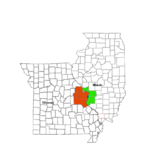
Cahokia was a village in St. Clair County, Illinois, United States. It was located east of the Mississippi River in the Greater St. Louis metropolitan area. As of the 2010 census, 15,241 people lived in the village, a decline from 16,391 in 2000. On May 6, 2021, the village ceased to exist, being incorporated into the new city of Cahokia Heights.

Ste. Genevieve is a city in Ste. Genevieve Township and is the county seat of Ste. Genevieve County, Missouri, United States. The population was 4,999 at the 2020 census. Founded in 1735 by French Canadian colonists and settlers from east of the river, it was the first organized European settlement west of the Mississippi River in present-day Missouri. Today, it is home to Ste. Genevieve National Historical Park, the 422nd unit of the National Park Service.

The Illinois Confederation, also referred to as the Illiniwek or Illini, were made up of 12 to 13 tribes who lived in the Mississippi River Valley. Eventually member tribes occupied an area reaching from Lake Michicigao (Michigan) to Iowa, Illinois, Missouri, and Arkansas. The five main tribes were the Cahokia, Kaskaskia, Michigamea, Peoria, and Tamaroa. The spelling Illinois was derived from the transliteration by French explorers of iliniwe to the orthography of their own language. The tribes are estimated to have had tens of thousands of members, before the advancement of European contact in the 17th century that inhibited their growth and resulted in a marked decline in population.

The Kaskaskia were one of the indigenous peoples of the Northeastern Woodlands. They were one of about a dozen cognate tribes that made up the Illiniwek Confederation, also called the Illinois Confederation. Their longstanding homeland was in the Great Lakes region. Their first contact with Europeans reportedly occurred near present-day Green Bay, Wisconsin, in 1667 at a Jesuit mission station.

The Illinois Country — sometimes referred to as Upper Louisiana —was a vast region of New France claimed in the 1600s in what is now the Midwestern United States. While those names generally referred to the entire Upper Mississippi River watershed, French colonial settlement was concentrated along the Mississippi and Illinois Rivers in what is now the U.S. states of Illinois and Missouri, with outposts on the Wabash River in Indiana. Explored in 1673 from Green Bay to the Arkansas River by the Canadien expedition of Louis Jolliet and Jacques Marquette, the area was claimed by France. It was settled primarily from the Pays d'en Haut in the context of the fur trade, and in the establishment of missions from Canada by French Catholic religious orders. Over time, the fur trade took some French to the far reaches of the Rocky Mountains, especially along the branches of the broad Missouri River valley. The French name, Pays des Ilinois, means "Land of the Illinois [plural]" and is a reference to the Illinois Confederation, a group of related Algonquian native peoples.
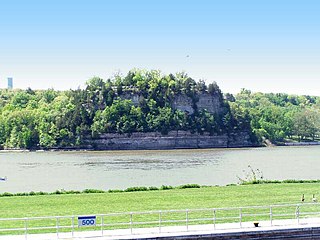
Starved Rock State Park is a state park in the U.S. state of Illinois, characterized by the many canyons within its 2,630 acres (1,064 ha). Located just southeast of the village of Utica, in Deer Park Township, LaSalle County, Illinois, along the south bank of the Illinois River, the park hosts over two million visitors annually, the most for any Illinois state park.

Fort de Chartres was a French fortification first built in 1720 on the east bank of the Mississippi River in present-day Illinois. It was used as the administrative center for the province, which was part of New France. Due generally to river floods, the fort was rebuilt twice, the last time in limestone in the 1750s in the era of French colonial control over Louisiana and the Illinois Country.
The Tamaroa were a Native American people in the central Mississippi River valley of North America, and a member of the Illiniwek or Illinois Confederation of 12 or 13 tribes. The name "Tamaroa" is a derivative of the word tamarowa meaning "cut tail" in Illiniwek and relates to a totemic animal such as bear or wildcat. An Algonquian-speaking group, like the rest of the Illiniwek, they lived on both sides of the Mississippi River in the area of the confluence with the Illinois and Missouri Rivers. Tamaroan culture is presumed to be similar to that of the Kaskaskia, Peoria, and other Illinois tribes.

The American Bottom is the flood plain of the Mississippi River in the Metro-East region of Southern Illinois, extending from Alton, Illinois, south to the Kaskaskia River. It is also sometimes called "American Bottoms". The area is about 175 square miles (450 km2), mostly protected from flooding in the 21st century by a levee and drainage canal system. Immediately across the river from St. Louis, Missouri, are industrial and urban areas, but nearby marshland, swamps, and the Horseshoe Lake are reminders of the Bottoms' riparian nature.
The Illinois Historic Preservation Division, formerly Illinois Historic Preservation Agency, is a governmental agency of the U.S. state of Illinois, and is a division of the Illinois Department of Natural Resources. It is tasked with the duty of maintaining State-owned historic sites, and maximizing their educational and recreational value to visitors or on-line users. In addition, it manages the process for applications within the state for additions to the National Register of Historic Places.

The Vandalia State House, built in 1836, is the fourth capitol building of the U.S. state of Illinois. It is also the oldest capitol building in Illinois to survive, as the first, second, and third capitol buildings have all disappeared. The brick Federal style state house has been operated by the state of Illinois as a monument of Illinois' pioneer years since 1933. It is located in Vandalia, Illinois, on the National Road, and listed on the National Register of Historic Places.

The Grand Village of the Illinois, also called Old Kaskaskia Village, is a site significant for being the best documented historic Native American village in the Illinois River valley. It was a large agricultural and trading village of Native Americans of the Illinois confederacy, located on the north bank of the Illinois River near the present town of Utica, Illinois. French explorers Louis Joliet and Father Jacques Marquette came across it in 1673. The Kaskaskia, a tribe of the Illiniwek people lived in the village. It grew rapidly after a French mission and fur trading post were established there in 1675, to a population of about 6,000 people in about 460 houses. Around 1691 the Kaskaskia and other Illiniwek moved further south, abandoning the site due to pressure from an Iroquois invasion from the northeast.
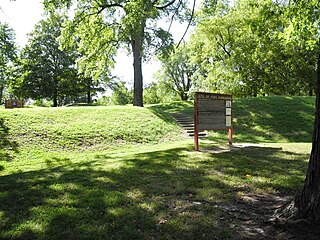
Fort Kaskaskia State Historic Site is a 200-acre (0.8 km²) park near Chester, Illinois, on a blufftop overlooking the Mississippi River. It commemorates the vanished frontier town of Old Kaskaskia and the support it gave to George Rogers Clark in the American Revolution.
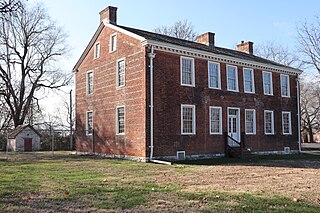
The Nicholas Jarrot Mansion is a historic house at 124 East First Street in Cahokia Heights, Illinois and is operated as an inactive historic site by the Illinois Historic Preservation Agency (IHPA). It is a State Historic Site, is listed on the National Register of Historic Places, and became a National Historic Landmark in 2001. Built in 1807–1810 for the son of French colonists, it is an extremely rare example of Federal architecture in the upper Mississippi River valley.

The Church of the Holy Family is a Roman Catholic church located at 116 Church Street in the St. Clair County, Illinois city of Cahokia Heights. Built beginning in 1786, it is a remarkably unaltered example of the French colonial construction style known as "poteaux-sur-solle" (post-on-sill), and one of the few such buildings surviving in North America. It was declared a National Historic Landmark and added to the National Register of Historic Places in 1970. The occupying congregation is the oldest continuously active Catholic Parish in the United States, having been founded in 1699 by Canadian missionaries, and the oldest church west of the Allegheny Mountains. At the invitation of Bishop Edward Braxton, the Institute of Christ the King Sovereign Priest continues to offer Mass in this historic church according to the Missal of 1962. Visitors are also welcome for guided tours in the summer. In celebration of the 2018 Illinois Bicentennial, Holy Family Church was selected as one of the Illinois 200 Great Places by the American Institute of Architects Illinois component.

Le Grand Champ is an alluvial floodplain, also called a bottom, extending along the Mississippi River in Ste. Genevieve County, Missouri.
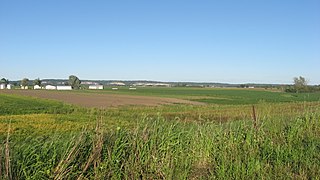
The Kolmer Site is an archaeological site in the far southwest of the U.S. state of Illinois. Located near Kaskaskia and Prairie du Rocher in western Randolph County, it lies at the site of an early historic Indian village from the French period. Because it occupies a critical chronological and cultural position, it has been given national recognition as a historic site.
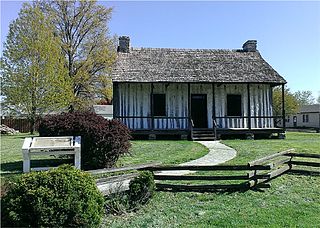
The Pierre Martin House is a single-family French Colonial House and historic site in East Carondelet, Illinois about 1.5 miles (2.4 km) East of the Mississippi River. The house, built circa 1790, is owned by the Illinois Historic Preservation Agency. and located at the intersection of First Street and Old Route 3 in North Dupo.
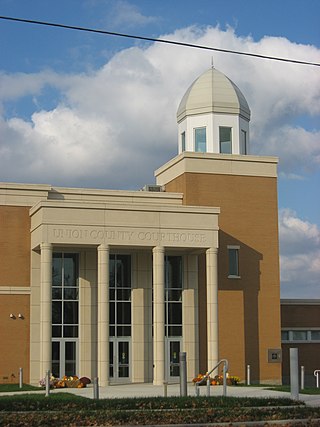
The Union County Courthouse is a government building in central Jonesboro, the county seat of Union County, Illinois, United States. Built in 2013, it replaced a brick structure whose core predated the Civil War.

The St. Clair County Courthouse is a government building in Belleville, the county seat of St. Clair County, Illinois, United States. Built in 1976, it is the fifth courthouse in the history of the county, and one of two that still stands.






















